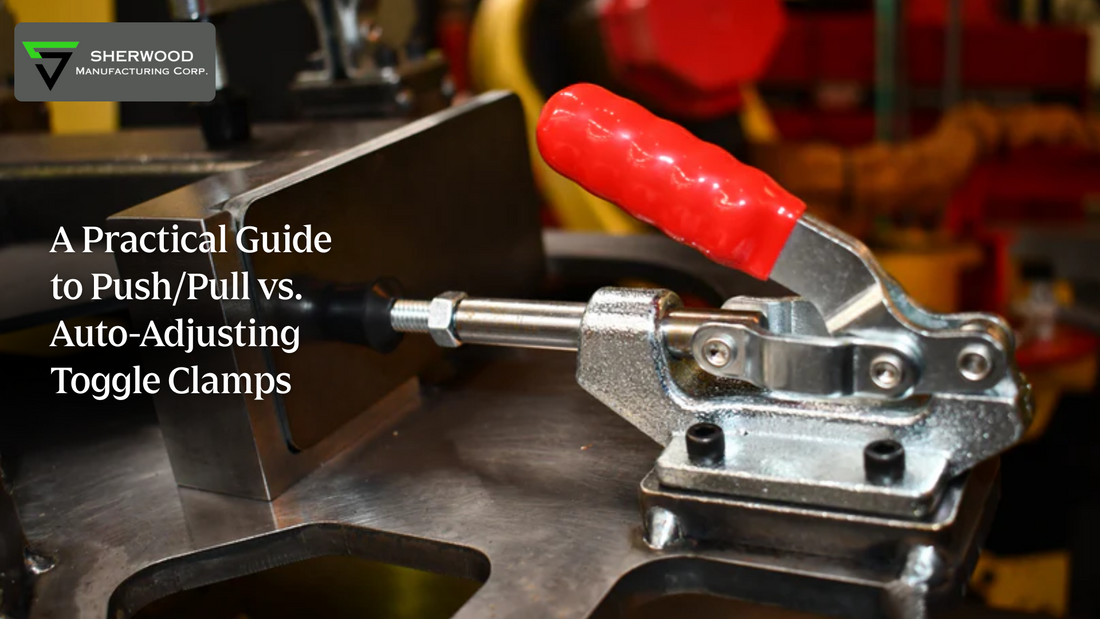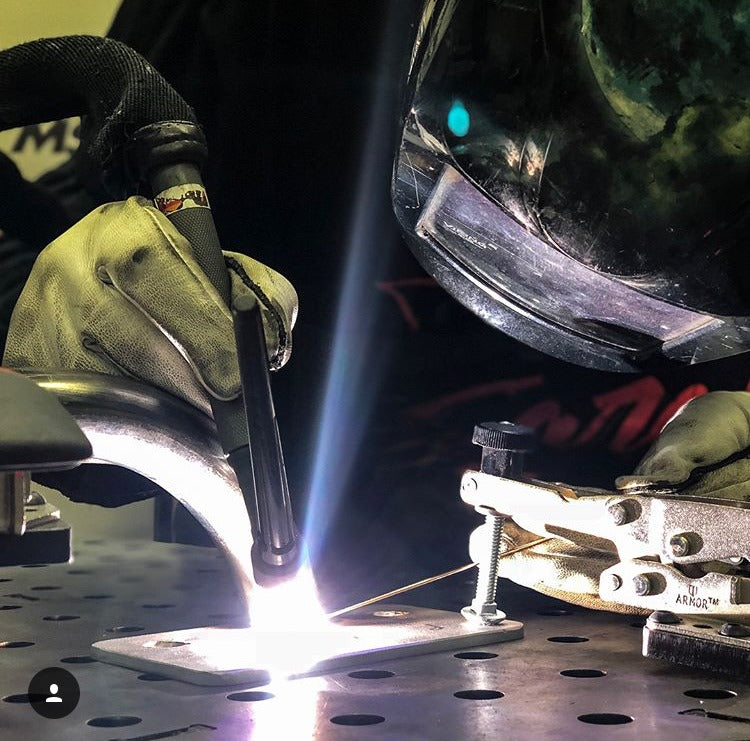
A Practical Guide to Push/Pull vs. Auto-Adjusting Toggle Clamps
Share
Introduction: Why Clamp Selection Matters in Manufacturing
In modern U.S. manufacturing, efficiency and precision are everything. Whether you’re assembling furniture, fabricating automotive components, or producing aerospace-grade materials, even the smallest tool choices can make or break your workflow. One of those critical tools is the toggle clamp, a simple yet powerful device that secures workpieces in place during machining, welding, or assembly.
Choosing the right type of clamp is more than a technical decision; it directly impacts speed, accuracy, operator safety, and long-term costs. In this guide, we’ll compare Push/Pull Toggle Clamps and Auto-Adjusting Toggle Clamps, highlighting their features, benefits, and applications. By the end, you’ll have a clear understanding of which clamp best suits your project requirements.
What Are Push/Pull Toggle Clamps?
Push/Pull Toggle Clamps are versatile clamping devices that secure workpieces using a plunger mechanism, which locks firmly into place whether pushing or pulling. They’re widely used in woodworking, metal fabrication, and assembly lines because once engaged, they deliver steady, vibration-resistant pressure that won’t loosen during repetitive tasks or heavy-duty operations. This makes them a go-to choice for industries where precision and consistency are essential.
Sherwood’s range shows how compact yet powerful these clamps can be. For instance, the GH-36003-RBS provides strong holding force in tight spaces, making it perfect for fixture setups where every inch of clearance matters. Meanwhile, the GH-36003-C features a carriage bolt that allows it to be used in high heat applications where a rubber spindle cannot be used. Both options help manufacturers improve efficiency, reduce downtime, and maintain accuracy over long production runs.
What Are Auto-Adjusting Toggle Clamps?

Auto-Adjusting Toggle Clamps are designed to simplify clamping by automatically adapting to different workpiece sizes and shapes. Unlike traditional clamps that require manual setup, these adjust instantly, saving valuable time in fast-paced manufacturing. This makes them especially useful in woodworking, furniture production, and general assembly lines where materials often vary in thickness.
The real advantage is speed and consistency. Operators can secure workpieces without resetting clamp pressure, reducing downtime, minimizing errors, and streamlining workflow. Sherwood’s collection highlights this efficiency models like the STC-IHH25-618-5-75-RR are engineered for precision and reliability in repetitive tasks, while the STC-HH50-618-1-00-LF delivers higher holding power with flexible adjustment for larger assemblies. Together, they give manufacturers the perfect balance of flexibility and strength to keep production moving smoothly.
Explore Sherwood’s Auto-Adjusting Clamps Collection to see how these tools can transform your process.
Key Differences Between Push/Pull and Auto-Adjusting Clamps
While both clamp types provide strong holding power, their differences determine where they shine.
-
Adjustability vs. Fixed Setup
Push/Pull clamps are highly reliable but require manual adjustments for different material sizes. Auto-adjusting clamps adapt automatically, saving time.
-
Strength vs. Flexibility
Push/Pull clamps generally provide a stronger holding force, making them ideal for heavy-duty tasks. Auto-adjusting clamps prioritize flexibility and efficiency over raw power.
-
Manual vs. Automated Operation
Push/Pull clamps rely on operator control for setup, while auto-adjusting clamps simplify operations with self-regulation.
Each type offers advantages, and understanding these distinctions is essential when aligning clamp choice with project requirements.
Performance in Real Manufacturing Settings
When it comes to real-world performance, both clamp types have their strengths.
-
Heavy-Duty Tasks
Push/Pull clamps dominate in environments like automotive welding and aerospace fabrication. Their strength and consistency make them the safest option for high-load applications.
-
Flexibility Production Runs
Auto-adjusting clamps shine in constantly changing environments such as welding prototype areas. Workers save valuable time by avoiding constant readjustments.
-
Mixed-Material Environments
In workshops that handle a mix of metals, plastics, or woods, auto-adjusting clamps offer unmatched adaptability. Push/Pull clamps, while reliable, may slow operations if frequent resizing is needed.
Safety and Ergonomics: Operator-Friendly Features
Safety and ergonomics are often overlooked when selecting clamps, yet they directly impact productivity.
Push/Pull clamps are known for their robust, predictable action, but they require more manual force. This can cause operator fatigue during long shifts.
Auto-adjusting clamps reduce strain by minimizing repetitive adjustments. Operators can maintain smoother workflows with less effort, lowering the risk of injury while improving efficiency.
For U.S. companies focused on compliance with OSHA safety standards, ergonomically designed clamps can also help meet workplace safety requirements.
Choosing the Right Clamp for Your Project

To decide which clamp suits your project, consider these factors:
-
Project Needs: For repetitive heavy-duty welding or metal fabrication, Push/Pull clamps provide superior holding power. For flexible, fast-paced tasks, Auto-Adjusting clamps are the better fit.
-
Material Types: If your workflow involves materials of varying sizes and thicknesses, auto-adjusting saves time.
-
Budget & ROI: Smaller workshops may benefit from Push/Pull’s affordability, while larger factories see greater value from Auto-Adjusting clamps’ long-term efficiency.
-
Industry Focus: Automotive and aerospace lean toward Push/Pull, while furniture and consumer goods industries often prefer Auto-Adjusting.
By aligning these factors with your production goals, you’ll make a clamp choice that enhances both productivity and cost-effectiveness.
Frequently Asked Questions (FAQ)
Q1: Are auto-adjusting clamps as strong as push/pull clamps?
Not always. Push/Pull clamps typically provide higher raw holding power, but auto-adjusting clamps offer sufficient strength for most light-to-medium manufacturing applications.
Q2: Which clamp is better for repetitive high-volume tasks?
Auto-adjusting clamps are superior in repetitive environments, as they reduce setup time and operator fatigue.
Q3: Do auto-adjusting clamps work with all material thicknesses?
Yes, within their design limits. They are built to automatically adapt to a wide range of sizes without manual changes.
Q4: How long do push/pull clamps typically last?
With proper maintenance, push/pull clamps can last for years, even under heavy-duty use. Their durability is one of their strongest benefits.
Q5: Can both types be used in the same project setup?
Absolutely. Many U.S. manufacturers combine push/pull and auto-adjusting clamps to cover different stages of production efficiently.
Conclusion: Making the Smart Choice
Selecting the right toggle clamp is not just about cost or convenience, it’s about aligning the tool with your specific manufacturing needs. Push/Pull clamps offer unmatched strength and reliability, making them ideal for heavy-duty, precision-focused tasks. Auto-Adjusting clamps, on the other hand, provide speed and adaptability, saving valuable time in dynamic production environments.
For U.S. manufacturers, the decision ultimately comes down to balancing power, flexibility, and long-term ROI. Both clamp types have their place, and when chosen wisely, they can significantly improve workflow efficiency and safety.

